The post Before a Disaster: Plan for Your Pets appeared first on Friends of the Palo Alto Animal Shelter.
]]>Most of us who are paying attention already have our family emergency kit organized. Water, food supplies, toilet and hygiene items, warm clothes, blankets etc. But what about our pets?
We must ask ourselves – will the dog and cat come with us if we have to leave the house for our own safety? If we must go to a shelter that doesn’t allow animals, will they have to remain in our house, garage? If not, what shelter can they go to, how will they be cared for? Do I have a backup plan for caring for my pet? How will I find them afterward?
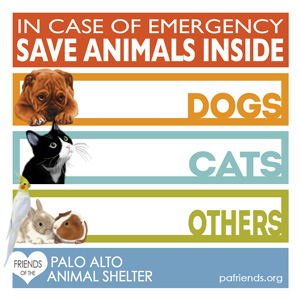
First step: Get a Rescue Alert Sticker
FoPAAS made this sticker for your home. This easy-to-use sticker will let people know that pets are inside your home. Make sure it is visible to rescue workers. Come and get your free sticker at our table at Downtown Farmer’s Market.
Remembering most of the city workers, the fire and police we depend on to help us in time of trouble, will not be able to reach us – most live in other cities. If roads and bridges are down, how will they get here? We should expect to be on our own for up to 5 days after the event.
We should be prepared for all possibilities. Have a kit set up, preferably a crate or other carrier where you can place your pet quickly. Have all his documents, including his vet’s name, any special health concerns, meds, and also a photo of you with your pet for identification purposes. Most people have their pets micro-chipped but make sure that crate contains an extra leash and collar with his tags.
Here is a list of items that should be included in the pet carrier, including the Pet Emergency First Aid Kit.
This should be ready and stored in an easily accessible location.
- Crate with soft clean bedding
- Food – kibble, cans with easy open tops and dishes for food and water
- Gallon jug of water with screw on top
- Cat litter pan and litter
- Doggie bags, newspapers, paper towels
- Current photo of you with your pet to help identification if separated
- Name and number of your vet and any medical conditions. I.e.: diabetic animal requiring shots
- Meds and med records stored in waterproof envelope
- Extra leash and collar or harness
- Booties to protect little feet from broken glass
- A small familiar toy to comfort the animal
- Pets should always be wearing collars with all up to date tags
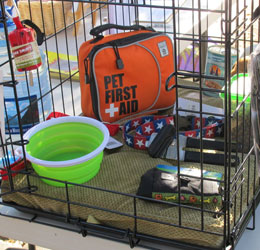
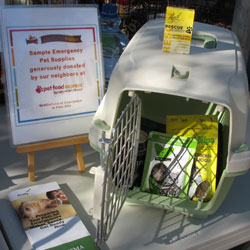
Very important to remember: any catastrophic event is hard on your pet. The sounds, the energy, your own fear, is recognized by the animal and they will be as traumatized just as we are. We must make an effort to calm their fears, create as much normalcy for them as possible, while taking care of all the members of your family.
Pet Emergency First Aid Kit
- First aid manual for pets
- Exam gloves
- First aid tape
- Tweezers
- Blunt tip Scissors
- 4 gauze pads 7x7cm
- 4 gauze pads 5x5cm
- 3 gauze rolls
- Saline Solution
- 8 Antiseptic Wipes
- 2 Wooden Tongue Depressors
- Reusable Woven Cloth Triangle Bandage
- Instant Cold Pack
- 2 Patch Adhesive Bandages
- Elastic Bandage
- Emergency Blanket
 About the Author
About the AuthorJeremy Lindston Robinson, our Vice President
Photo Credit: The U.S. Army
The post Before a Disaster: Plan for Your Pets appeared first on Friends of the Palo Alto Animal Shelter.
]]>The post Hunting for Foxtails appeared first on Friends of the Palo Alto Animal Shelter.
]]>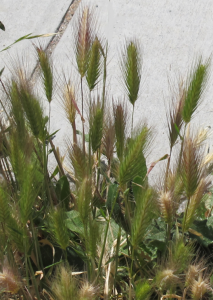 The tiny seed moves slowly, relentlessly. With every breath, with every movement, it snuggles deeper into the fur as it inches forward, always seeking, never stopping. Finally it reaches flesh and the journey continues, piercing tender skin, and now it’s in the tissues, sliding between layers of muscle, inexorably toward the heart of the animal.
The tiny seed moves slowly, relentlessly. With every breath, with every movement, it snuggles deeper into the fur as it inches forward, always seeking, never stopping. Finally it reaches flesh and the journey continues, piercing tender skin, and now it’s in the tissues, sliding between layers of muscle, inexorably toward the heart of the animal.
This is a foxtail. It’s hard to believe this sharp pointed seed with its barbed tail is not a malevolent intelligent being whose sole objective is to seek and kill.
My beautiful collie Mr. Chadwick, with his heavy flowing coat, was a victim of a foxtail. Luckily, I discovered the lump on his chest. Seeing the inverted seeping entrance wound sent us straight to our vet and emergency surgery. The foxtail they found had journeyed within a quarter-inch of entering his heart muscle. That foxtail almost killed the best dog ever.
Foxtails are everywhere now. I just found one on my beagle that had already entered her skin, aiming straight for her throat. We live in the city—no weeds or foxtails anywhere in our manicured lawns and gardens—and yet, there it was. Sneaky, determined, mindless.
Foxtails get into your pet’s ears—both dogs and cats. If not discovered, the seed burrows along the ear canal, causing deafness before entering the brain. A good sniff can suck one into a dog’s nose to begin its relentless journey, again straight to the brain. Even when the organ it enters is not vital, infection ensues. When it enters the foot, finding the delicate tissues between the pads, the seed can cause lameness and infection. And when it enters the eye, surgery may be required before blindness and infection result.
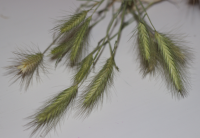 Check your pet frequently—around the eyes, ears, and feet, running your hands over her body—searching for the tell-tale sharp talons of this frightful seed. And remember, this malevolent threat can be anywhere; it attaches to your clothes, sticks in your socks, gets into your shoes—so check those as well. We must be constantly vigilant for our beloved pets.
Check your pet frequently—around the eyes, ears, and feet, running your hands over her body—searching for the tell-tale sharp talons of this frightful seed. And remember, this malevolent threat can be anywhere; it attaches to your clothes, sticks in your socks, gets into your shoes—so check those as well. We must be constantly vigilant for our beloved pets.
 About the Author
About the AuthorJeremy Lindston Robinson, our Vice President
Photo Credit: Adobe Pet Hospital
The post Hunting for Foxtails appeared first on Friends of the Palo Alto Animal Shelter.
]]>The post The Lure of the Easter Bunny appeared first on Friends of the Palo Alto Animal Shelter.
]]>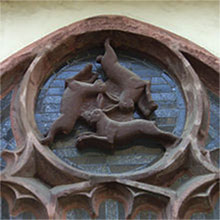
Window of Three Hares in Paderborn Cathedral in Paderborn, Germany
The Easter Bunny has been around for a very long time. As early as 1682, there was a reference to the German tradition of an Easter Hare bringing Easter Eggs for the children. Sometimes a live rabbit would be brought to the church, representing the Easter Bunny. The rabbit can be found in medieval church art as well, as it has been connected with the Virgin Mary, the Holy Trinity, and the fertility of springtime. Christians of the Eastern Orthodox Church would dye eggs red for Easter, recognizing the blood of Christ but also the renewal of spring. Some used the color green to honour new foliage, and the Ukrainian art of decorating eggs for Easter dates to ancient, pre-Christian times. Who but the Easter Bunny would carry these eggs to the children?
Thus in modern America, the Easter Bunny visits children with baskets of chocolate or candy eggs. And sometimes a real bunny is given to a child at Easter. What could be sweeter than your own soft, cuddly little bunny rabbit to cuddle and play with?
Before you bring home a rabbit for your child, here are some thoughts to consider:
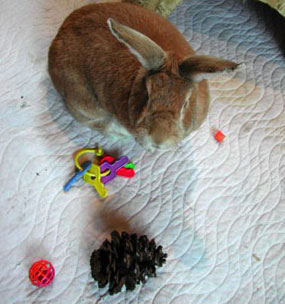
Buckaroo with rabbit toys
- Bunnies don’t like to be held. They may think you are a predator who wants to hurt them. They might struggle, bite, or run away. They cannot be passive. Their instincts as prey animals tell them to escape.
- They can be shy and jumpy and can take a while learning to trust you. A child may soon be put off or, on the positive side, may have the opportunity to learn patience.
- Bunnies are delicate and can easily be hurt if stepped on or handled improperly.
- A rabbit can live ten years or more and requires as much care as a dog or cat, including the need for spay/neuter surgery.
- They can be trained to a litter box, but you must keep it clean, as well as their cage.
- Rabbits need exercise, and when they enjoy running around the house, they can leave a trail of dry pellets behind.
- Rabbits love to chew on electrical power cords. Just think about that one!
- The main portion of a rabbit’s diet must be hay, with a small amount of greens. In fact, you should only provide carrots in tiny portions as an occasional treat. Bugs Bunny is not a healthy role model for your rabbit!
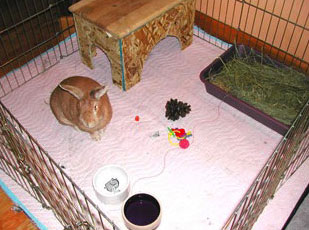
House Rabbit Habitat. Use an old blanket or rug under the exercise-pen. This protects your floor, and can be easily washed and gives your bunny a soft place to play.
When the bunny—now a full grown rabbit—is more trouble to care for than expected, that well intended Easter gift may be dropped off at the local animal shelter. In fact, each year by six weeks after Easter, shelters have an abundance of rabbits who need new loving homes. A worse choice of irresponsible rabbit owners is to dump the creature outside on its own. In such a case, the rabbit ends up as a meal for a predator because a domesticated rabbit cannot fend for itself in the wild.
For some great suggestions from organizations that specialize in the care and adoption of rabbits, visit these websites: www.saveabunny.org and www.rabbit.org . These wonderful non-profits take in abandoned rabbits, providing veterinary care, spay/neuter surgery, and finding new homes. You can make donations easily online.
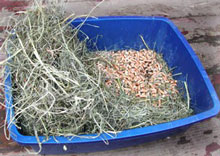
A rabbit litterbox. Use a plastic cat litter pan, put a layer of pellet stove pellets on the bottom, next put a few handfuls of hay, and top with fresh grass hay daily.
If the idea of having a pet rabbit still appeals to the children of your house, suggest they visit the local animal shelter where they can become acquainted with the rabbits. Watch to see how rabbits are cared for, get to know what owning a little creature like that is really like. Another excellent option would be to contact a rabbit rescue group near you to learn about fostering a rabbit. No one can deny rabbits are soft and adorable, but as one boy who volunteers at a shelter caring for the rabbits said “They don’t play with you like a dog would, and they won’t come when they’re called, unless they feel like it. They have their own way of doing things, and there’s stuff going on in their heads that you can’t know unless you really watch and pay attention.”
Right now our local Palo Alto Animal Services has some beautiful rabbits available for adoption. This Easter, when you visit the pet store and are tempted by the soft, furry, cuddly little bunny rabbits, be sure in your own mind that you are ready to take responsibility for proper care and feeding.
 About the Author
About the AuthorJeremy Lindston Robinson, our Vice President
The post The Lure of the Easter Bunny appeared first on Friends of the Palo Alto Animal Shelter.
]]>The post Allergies in Pets appeared first on Friends of the Palo Alto Animal Shelter.
]]> Cookie is a dainty Pocket Beagle with huge dark eyes and a sweet nature, but she licked her paws—constantly. Her feet were always damp as she rotated from one paw to another.
Cookie is a dainty Pocket Beagle with huge dark eyes and a sweet nature, but she licked her paws—constantly. Her feet were always damp as she rotated from one paw to another.
An allergy to pollen caused her paws to become extremely itchy, especially in summer. And because her licking created a warm, moist place, a yeast infection quickly followed—thus exacerbating the irritation. A savvy vet recognized the problem, and recommended Benadryl for Cookie’s allergy. (A basic antihistamine, Benadryl is available over the counter at local drugstores.)
In addition, the veterinarian prescribed a medicated shampoo for Cookie, who is now bathed with it once a week to keep the secondary yeast infection at bay. When it works, topical treatment such as the shampoo is preferred over pills.
 In another case, the family of Elsie, a one-year-old Brittany Spaniel, found her lying unconscious in their back yard. At the Emergency Veterinarian’s office, they learned that Elsie had been stung by a bee, to which she had an extreme allergy. Elsie had gone into anaphylactic shock, which can kill a dog within minutes. If dogs roll on grass or bite at a bee as it buzzes around them, they are susceptible to bee-stings.
In another case, the family of Elsie, a one-year-old Brittany Spaniel, found her lying unconscious in their back yard. At the Emergency Veterinarian’s office, they learned that Elsie had been stung by a bee, to which she had an extreme allergy. Elsie had gone into anaphylactic shock, which can kill a dog within minutes. If dogs roll on grass or bite at a bee as it buzzes around them, they are susceptible to bee-stings.
With treatment Elsie recovered quickly, and now her family is never without an epi-pen nearby in the event of another episode. Since the initial attack, Elsie has been stung once again and has been stabilized by the family that loves her, using an epi-pen.
Our pets are subject to allergies, just as we are. They can be allergic to foods, all the airborne allergens we suffer from, as well as fleas, cleaning products, insecticidal shampoos, drugs, even perfumes. And like us, the symptoms of their allergic reactions include sneezing, itching, vomiting, or diarrhea. If you recognize a problem, your veterinarian is able to offer fast and effective treatment.

To cut down on dust and allergens, clean bedding is important for your pet. Frequent bathing removes pollens and allergens from their skin. If your veterinarian suspects a food allergy, she may prescribe a hydrolyzed protein diet followed by specific foods, or a home-cooked diet that eliminates the offending food, once it is identified.
Being aware of your pet’s health and behavior is key to a happy animal. Cookie was very lucky to have Gwen who was determined to address the licking problem and succeeded. And little Elsie was fortunate indeed to have a family that dropped everything and found help for her quickly. We must be mindful that our beloved pets have similar concerns to ours, and they need us to take care of them. That is our promise to them.
 About the Author
About the AuthorJeremy Lindston Robinson, our Vice President
The post Allergies in Pets appeared first on Friends of the Palo Alto Animal Shelter.
]]>The post Enthralling, Exemplary, Elegant Ebony Cats appeared first on Friends of the Palo Alto Animal Shelter.
]]>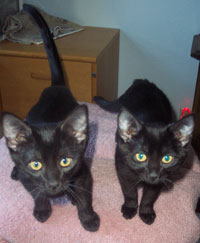 There’s a life-threatening plague sweeping the nation this very moment: the Black Cat Syndrome. It’s causing humans the deprivation of cuddly companions and is even more life-threatening to the furry felines.
There’s a life-threatening plague sweeping the nation this very moment: the Black Cat Syndrome. It’s causing humans the deprivation of cuddly companions and is even more life-threatening to the furry felines.
Mischievous misconceptions concerning not only black cats, but black animals in general, are actually causing the deaths of many healthy shelter animals. On the bottom of adoption lists, and thus on the top of the euthanasia lists of overcrowded shelters, are black cats. But what ridiculous rumors are preventing these black beauties from attracting prospective adopters who are looking for a loving friend? And do these rumors have any ground?
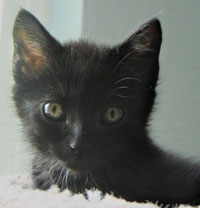 The old saying that a black cat crossing your path bodes bad luck is actually not that old at all. It’s only about as old as the United States, which, compared to other civilizations, is relatively young. In fact, in almost every other country, there’s an even older saying: black cats bring good luck. The Egyptians, for example, worshipped the black cat goddess Bast. In Europe, a black cat crossing your path bodes well for the fortunate pedestrian, while a black cat walking in to your house is a true blessing. The English believe that black cats bring safe seafaring to fishermen, and
The old saying that a black cat crossing your path bodes bad luck is actually not that old at all. It’s only about as old as the United States, which, compared to other civilizations, is relatively young. In fact, in almost every other country, there’s an even older saying: black cats bring good luck. The Egyptians, for example, worshipped the black cat goddess Bast. In Europe, a black cat crossing your path bodes well for the fortunate pedestrian, while a black cat walking in to your house is a true blessing. The English believe that black cats bring safe seafaring to fishermen, and 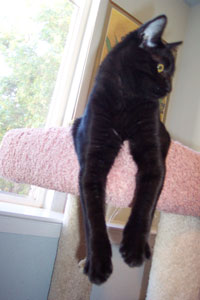 King Charles I’s luck only ran out when his beloved black cat died. In Japan, a black maneki-neko (beckoning cat) signifies good health. Black cats, with their mysterious coloring, only incurred the skepticism of the overcautiously suspicious Pilgrims. They linked black cats with witches, not unlike the black silhouettes on the back of witches’ broomsticks we picture today. But just because the silhouette is black, who’s to say that the cat is black as well? It could be a tabby cat, or a calico cat, or even a pearl-white cat perched on that stick, for all we know. All their silhouettes look exactly the same. And as for cats being associated with witches, I’ve heard many a spell that includes cat’s brains, or cat’s eyes, or cat’s tails; I don’t think cats like being around witches and their cauldrons more than anybody else.
King Charles I’s luck only ran out when his beloved black cat died. In Japan, a black maneki-neko (beckoning cat) signifies good health. Black cats, with their mysterious coloring, only incurred the skepticism of the overcautiously suspicious Pilgrims. They linked black cats with witches, not unlike the black silhouettes on the back of witches’ broomsticks we picture today. But just because the silhouette is black, who’s to say that the cat is black as well? It could be a tabby cat, or a calico cat, or even a pearl-white cat perched on that stick, for all we know. All their silhouettes look exactly the same. And as for cats being associated with witches, I’ve heard many a spell that includes cat’s brains, or cat’s eyes, or cat’s tails; I don’t think cats like being around witches and their cauldrons more than anybody else.
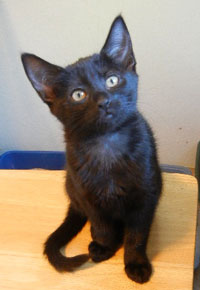 But aside from silly superstitions, there are other misconceptions haunting black cats. Perhaps due to the common image of black silhouettes of cats slinking around in the dead of night (again, a black silhouette does not always translate into a black cat), people often view black cats as shy, and prone to aggression (thanks to plastic black cats with raised hackles decorating trick-or-treaters’ yards). Almost one fourth of the 167 cats I have fostered have been black cats, and I can vouch for every single one of them. Although black cats, like any other cat, can start out shy when first rescued, the black cats I have known have been especially resilient. In fact, I would readily argue that black cats are the second most friendly type of cats (behind the widely accepted friendly orange tabby). That’s not to say that only black cats are friendly; but I have found that, generally speaking, black cats make great family pets. They seem to be particularly gentle with younger children, and are often affectionate lap cats with rumbling purrs. They certainly aren’t more prone to shyness or aggression than any other cat with any random fur coloring. Black cats are as fun-loving and friendly as any other cat, if not more so. On top of all that, scientists have found that the gene pattern related to black coloring might be linked to resistance to pathogens. So, black cats are healthier cats!
But aside from silly superstitions, there are other misconceptions haunting black cats. Perhaps due to the common image of black silhouettes of cats slinking around in the dead of night (again, a black silhouette does not always translate into a black cat), people often view black cats as shy, and prone to aggression (thanks to plastic black cats with raised hackles decorating trick-or-treaters’ yards). Almost one fourth of the 167 cats I have fostered have been black cats, and I can vouch for every single one of them. Although black cats, like any other cat, can start out shy when first rescued, the black cats I have known have been especially resilient. In fact, I would readily argue that black cats are the second most friendly type of cats (behind the widely accepted friendly orange tabby). That’s not to say that only black cats are friendly; but I have found that, generally speaking, black cats make great family pets. They seem to be particularly gentle with younger children, and are often affectionate lap cats with rumbling purrs. They certainly aren’t more prone to shyness or aggression than any other cat with any random fur coloring. Black cats are as fun-loving and friendly as any other cat, if not more so. On top of all that, scientists have found that the gene pattern related to black coloring might be linked to resistance to pathogens. So, black cats are healthier cats!
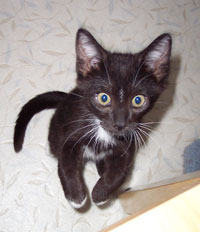 Another aspect that deters prospective adopters away from black cats is poor advertising photos. Black cats can be hard to photograph because they do blend into shadows, and their cute facial features are often lost due to lack of color variation and contrast. This problem, however, has an easy fix. As a shelter cat photographer, positioning the cat against a light background and allowing in lots of natural light highlights the glossy sheen of their alluringly ebony coats, while also allowing for some contrast that brings out their adorable faces. (If you’re an avid photographer with a high-quality camera and some spare
Another aspect that deters prospective adopters away from black cats is poor advertising photos. Black cats can be hard to photograph because they do blend into shadows, and their cute facial features are often lost due to lack of color variation and contrast. This problem, however, has an easy fix. As a shelter cat photographer, positioning the cat against a light background and allowing in lots of natural light highlights the glossy sheen of their alluringly ebony coats, while also allowing for some contrast that brings out their adorable faces. (If you’re an avid photographer with a high-quality camera and some spare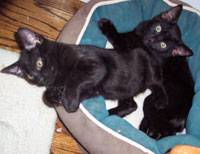 time, consider volunteering at your local animal shelter and help some black cats attract loving forever homes!) As a prospective adopter, realizing this little difficulty when browsing through online photos can help you keep an open mind. Try not to judge the cat solely on the picture (it’s not their fault the photographer didn’t ask for their good side!), but rather on their written personality biographies. Better yet, go to the shelter and see how cute black cats are in person.
time, consider volunteering at your local animal shelter and help some black cats attract loving forever homes!) As a prospective adopter, realizing this little difficulty when browsing through online photos can help you keep an open mind. Try not to judge the cat solely on the picture (it’s not their fault the photographer didn’t ask for their good side!), but rather on their written personality biographies. Better yet, go to the shelter and see how cute black cats are in person.
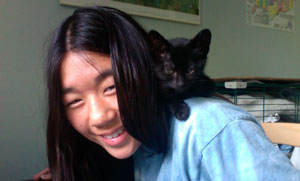 With Halloween coming up, black cats are especially vulnerable. Some organizations even stop adopting out black cats during October, for fear of people buying them just to set them lose on Halloween to scare young trick-or-treaters. Please be considerate during Halloween festivities: try to refrain from scary black cat decorations (stick with ginormous spiders — they’re actually scary!), and please keep your black cat indoors on Halloween if you don’t already always keep your cat within the safety of your home.
With Halloween coming up, black cats are especially vulnerable. Some organizations even stop adopting out black cats during October, for fear of people buying them just to set them lose on Halloween to scare young trick-or-treaters. Please be considerate during Halloween festivities: try to refrain from scary black cat decorations (stick with ginormous spiders — they’re actually scary!), and please keep your black cat indoors on Halloween if you don’t already always keep your cat within the safety of your home.
And if you’re looking for an enthralling, exemplary, elegant furry friend to brighten up your home, please consider an ebony cat! (Click here to see ebony cats up for adoption at PAAS!)
 About the Author
About the AuthorJoanna Tang, our Youth Board Liaison from Gunn High Scool
The post Enthralling, Exemplary, Elegant Ebony Cats appeared first on Friends of the Palo Alto Animal Shelter.
]]>The post All Hail the Noble Pumpkin appeared first on Friends of the Palo Alto Animal Shelter.
]]> Pumpkin season is almost here and with it a scrumptious addition to your dog or cat’s diet: pureed pumpkin. Not pumpkin pie filling with all those yummy spices—just plain old pumpkin.
Pumpkin season is almost here and with it a scrumptious addition to your dog or cat’s diet: pureed pumpkin. Not pumpkin pie filling with all those yummy spices—just plain old pumpkin.
There is something in pumpkin that cures what ails you; good for everything—sort of like Grandma’s lye soap. Pumpkin added to your pet’s food keeps them regular. It helps with indigestion and upset stomachs. It treats diarrhea and constipation with equal effectiveness.
Dogs love pumpkin, and added to their meal, it fills them up and gives them a satisfied feeling. You find pumpkin as an ingredient in high quality kibble for good reason.
If your dog is little on the hefty side, this is the answer! Reduce a portion of their regular food and replace it with the same portion of pumpkin. (A half cup is only 40 calories.) They will thank you for the tasty treat mixed with their boring kibble. A few teaspoons a day for little doggies and pups; a couple of tablespoons for the bigger dogs.
Though cats can be more finicky, they usually love pureed pumpkin, too. I know a cat who likes to lick the spoon used to add pumpkin to the dog’s dish.
Unsalted, roasted pumpkin seeds (called “pepitas”) are high in essential fatty acids and antioxidants, which are good for healthy skin and fur. The oils of the pumpkin flesh and seeds support urinary health. Pumpkin is a great source of Vitamin A, beta-carotene, potassium and iron and can even reduce the likelihood of cancer. And that’s it—the miracle of the noble pumpkin.
 About the Author
About the AuthorJeremy Lindston Robinson, our Vice President
Photo Credit: Scottie Zimmerman; jelene via Compfight cc
The post All Hail the Noble Pumpkin appeared first on Friends of the Palo Alto Animal Shelter.
]]>The post Dog Days of Summer appeared first on Friends of the Palo Alto Animal Shelter.
]]> Friends visiting a beach in Florida observed a small terrier racing into the water to retrieve a ball and return it to his owner, over and over again. What made this remarkable were the swim goggles the dog was wearing.
Friends visiting a beach in Florida observed a small terrier racing into the water to retrieve a ball and return it to his owner, over and over again. What made this remarkable were the swim goggles the dog was wearing.
Another nearby dog was wearing big sunglasses, a hat, and a sundress! Cute, yes, but not altogether frivolous as we learn how dogs can suffer from the challenges of summer.
Sunburn
Dogs can get sunburned just as people do. The skin becomes sensitive and may turn red, blister, and scab. Dogs with short white hair and dogs with thick hair that’s been trimmed for the summer can be more susceptible to sunburn.
If your dog is vulnerable, protect him from sunburn by applying sunscreen to the skin of his head and back. You may use a sunscreen designed for infants that contains no zinc. And there are sunscreens created specifically for dogs available at local pet stores.
Overheating
One of the biggest dangers in summer is the overheated car. Leaving a dog in the car, even with the windows open, is an invitation for heat stroke. As humans, we sweat through the skin on our entire body to cool down. The dog has no similar way to regulate his body temperature and can quickly become overheated.
Signs of a stroke in a dog are dizziness, unsure footing, and being disoriented. The bigger and longer the tongue is as they pant, the more likely they are to have heat exhaustion.
Dehydration
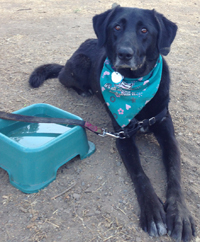 In the summertime, dogs enjoy a nap in the sun. Make sure your dog has access to clean water at all times—and shade. If a dog becomes dehydrated, his gums will feel dry, tacky, or sticky to your touch. For another simple test, gently pinch and lift the skin behind the dog’s shoulder blades—creating a “tent.” When you release it, if the skin is slow to settle back, the dog is dehydrated. In an extreme case, an emergency visit to the veterinarian is in order for quick rehydration with an IV or subcutaneous injection.
In the summertime, dogs enjoy a nap in the sun. Make sure your dog has access to clean water at all times—and shade. If a dog becomes dehydrated, his gums will feel dry, tacky, or sticky to your touch. For another simple test, gently pinch and lift the skin behind the dog’s shoulder blades—creating a “tent.” When you release it, if the skin is slow to settle back, the dog is dehydrated. In an extreme case, an emergency visit to the veterinarian is in order for quick rehydration with an IV or subcutaneous injection.
Swimming
 Many dogs love to swim, but not every dog is a natural swimmer. Most dogs can paddle, but getting out of a swimming pool can be difficult unless you provide a ramp or other dog-tailored means of egress.
Many dogs love to swim, but not every dog is a natural swimmer. Most dogs can paddle, but getting out of a swimming pool can be difficult unless you provide a ramp or other dog-tailored means of egress.
In addition, chemicals in swimming pool water can be harmful to a dog’s GI tract. Even the water in a local creek can contain single-cell organisms such as Giardia that can cause diarrhea. Swimming is good exercise and cooling in the summer. Just be aware of possible risks associated with the activity.
Summary
Most of the hazards of summer are easily avoidable with simple common sense. Our pets want to please us, and they can’t tell us how they are feeling or what they are afraid of. We have to be alert to any distress they may experience. We have made a sacred promise to give them care throughout their lives, and they reward us with their unconditional love. How precious is that?
 About the Author
About the AuthorJeremy Lindston Robinson, our Vice President
Image courtesy of federico stevanin / FreeDigitalPhotos.net
The post Dog Days of Summer appeared first on Friends of the Palo Alto Animal Shelter.
]]>The post Declawing Q ‘n’ A appeared first on Friends of the Palo Alto Animal Shelter.
]]>Is declawing painful to my cat?
YesIt is not like getting a nail trim or a manicure. Declawing your cat is equivalent to chopping a human’s fingers and toes off at the first knuckle. That hurts. Your cat will be in pain after he wakes up from the surgery, and the pain will continue for a long time, perhaps even for the rest of his life. Your cat’s claw can continue growing inside the paw, which becomes extremely painful.
Does declawing maim my cat?
YesLike a human who has had their toes chopped off, a cat must relearn how to walk and balance. This relearning process is straining to the muscles. In addition, common complications during the surgery include permanent nerve damage, skin disorders, and painful scar tissue formation and bone chips (which require additional surgery).
My cat stays indoors. Does he really need his claws?
YesClaws are your cat’s first line of defense. Even if you keep your cat indoors, there is always the possibility that he might slip through the door when you’re juggling four bags of groceries and your kid’s hyperactive playmate. If your declawed cat were ever to accidentally find himself outdoors, he would be easy prey for wildlife and stray dogs and cats. In addition, cats scratch as a form of exercise and playing. Depriving your cat of this natural exercise causes muscle deterioration.
But I have a baby and don’t want my cat to scratch him. A declawed cat is safer for my baby, right?
WrongSince claws are your cat’s first line of defense, robbing him of his claws causes him to feel very insecure. This insecurity often leads to aggression, unpredictability, and shyness. Declawed cats are more likely to bite your baby in self-defense (pudgy, flailing baby arms might seem harmless, but it hurts when your cat accidentally gets bopped in the nose!). Not only that, but declawed cats must resort to other means to mark their territory. This means that your cat is more likely to urinate and defecate outside of the litterbox. Not only will you be on diaper duty, you’ll have to clean up after your cat before your baby finds a “tasty treat.”
But declawing isn’t illegal, right?
Declawing is illegal in almost two dozen other countries, including Australia, England, and Japan, because it is viewed as horridly unethical. Although it’s not illegal in the USA, it’s widely seen as an atrocity, especially by veterinarians. Most vets refuse to perform the procedure because they consider it so unethical.
But I don’t want my cat destroying my furniture. Isn’t declawing my only option?
No
The main part of the claw that snags upholstery is the sharp, curved tip. Trimming your cat’s nails regularly will protect your furniture from serious damage. When your cat is calm and relaxed, gently squeeze his toes until his claws unsheath. Using cat nail clippers, trim off the tip of the nail, careful not to trim as far as the dark vein running through the claw, or the “quick.”
Along with regular trimmings, buying a few scratching posts will allow your cat to scratch his heart out without scratching to the heart of your sofa. Simple cat scratchers start at just around $5, but if you want something that will look classy in your living room, you can pamper your cat with scratchers like these:
I bought my cat a great cat scratcher, but he still scratches my couch instead. Is it time to declaw him?
NoDo not think of declawing as an alternative, or even as a “last resort.” Declawing is inhumane and absolutely avoidable. There are numerous ways to train your cat to only scratch his cat scratcher. One scratcher usually isn’t enough, so consider buying multiple (different kinds) of scratchers. Locate one near the sofa (or wherever your cat likes to scratch), and one near his bed (the morning routine cat stretch includes scratching). Make the scratcher a fun place: play with your cat there and sprinkle catnip, or even cat treats, on the scratcher. Never discourage your cat from scratching the sofa by physical force. Instead, deter your cat with a loud voice when he scratches the sofa. You can also put double-sided tape on “scratch-free zones,” or spray the area with a lemon scent (cats don’t like citrus). If your cat still refuses to break old habits, you can spray his back with lukewarm water when he goes for your sofa (however, do not spray kittens with water, as this is very traumatizing for them).
Will my cat still love me if I declaw him?
NoAnd isn’t that all that really matters?
 About the Author
About the AuthorJoanna Tang, our Youth Board Liaison from Gunn High Scool
Photo Credit: Steve Jurvetson
The post Declawing Q ‘n’ A appeared first on Friends of the Palo Alto Animal Shelter.
]]>The post The Perks of Being an Indoor Cat appeared first on Friends of the Palo Alto Animal Shelter.
]]>The main argument against keeping cats indoors is that people feel guilty about “trapping” their cats inside and not letting them enjoy the “freedom” of the outdoors. First, let’s examine all the risks of letting your cat “experience the outdoors.”
Indoor cats live an average of 7-15 years longer than outdoor cats. Some of the main life-threatening risks to life outdoors include being run over by cars and other traffic, ingesting poisons like pesticides, acquiring diseases from other cats, animals, and parasites, being attacked or getting into a fight with other cats, dogs, and wild animals, being susceptible to animal abusers, getting lost (which often leads to starvation), and even — gasp! — abandoning your house for your friendly neighbor’s home (OK, that last one’s not life-threatening for the cat, but it might be life-threatening for you, the broken-hearted).
Aside from the innumerable dangers the outdoors poses to your cat, your cat also poses many dangers to the outdoors. Outdoor cats kill birds and small wildlife (though most do not consume their prey, as there’s a tasty bowl of kibble waiting at home). An estimated hundreds of millions of birds are killed every year by outdoor cats, and these victims often end up massacred at the owner’s bloodstained doorstep, right before you’re settling down to enjoy dinner. Cats also chew up neighbor’s plants, and can generally cause a nuisance by clawing outdoor furniture, screens, and other pets and animals. Cats might also put you on your neighbor’s bad list by scent marking, urinating, and leaving feces on their new lawns, as well as yowling incessantly. And don’t even think about feeding your cat outdoors — cat food attracts other outdoor pets, as well as potentially dangerous wildlife like mountain lions and foxes.
As you can see, the cons heavily outweigh the pros of being an outdoor cat. Yes, cats like sniffing grass and chasing bugs. But the truth is, your cat’s curiosity of nature can be satiated inside the safety of your house. Providing plenty of indoor stimulation for your cat, like broad windowsills or window perches where your cat can see the great outdoors, screened windows so that your cat can smell the scents of nature, scratching posts, a variety of fun toys (see these Amazon lists for ideas: Best Rated Cat Toys and Supplies by Serena and Best Interactive Cat Toys ), comfy beds, plenty of human interaction, or even a feline playmate, will make the indoors your cat’s paradise. You can even grow a patch of potted cat grass for your kitty to munch on. Your cat will be completely happy indoors, and they’ll be safe, too!
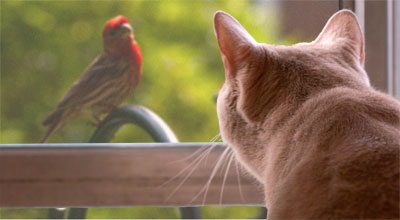 If you simply can’t stand the thought of “confining” your cat to life indoors, there is a safe solution: outdoor cat enclosures. Now, you don’t have to invest in thousands of dollars of chicken wire and get your enclosure on an Animal Planet episode about “The Most Outrageous Outdoor Enclosures.” You can start with a simple guinea pig cage, or an outdoor bunny fence with the top covered with secure towels or some spare plywood. Once you realize you have to pamper your cat even more, you can buy cat enclosures like these . Or, you can build your own .
If you simply can’t stand the thought of “confining” your cat to life indoors, there is a safe solution: outdoor cat enclosures. Now, you don’t have to invest in thousands of dollars of chicken wire and get your enclosure on an Animal Planet episode about “The Most Outrageous Outdoor Enclosures.” You can start with a simple guinea pig cage, or an outdoor bunny fence with the top covered with secure towels or some spare plywood. Once you realize you have to pamper your cat even more, you can buy cat enclosures like these . Or, you can build your own .
As you can see, there are plenty of safe alternatives to letting your cat roam outdoors. From window perches to outdoor cat enclosures, you can keep your cat both happy and healthy! Indoor life is the way to go when thinking of your furry friend’s safety and happiness.
 About the Author
About the AuthorJoanna Tang, our Youth Board Liaison from Gunn High Scool
Photo Credit: Derrick Coetzee
The post The Perks of Being an Indoor Cat appeared first on Friends of the Palo Alto Animal Shelter.
]]>The post Your Dog’s Paw appeared first on Friends of the Palo Alto Animal Shelter.
]]>It was clear to me that the dog was in distress and his master was unaware of that, plugged in as he was to his iPod. I expressed concern that his dog had injured his foot and when I enquired the owner said he had noticed that the dog was lagging behind but had not checked to see why. I offered the dog some water from my bottle which he gratefully lapped up very quickly. Then I casually asked if he thought the pavement may be a little hot for the dog’s feet.
The man had never considered that. He, wearing thick soled running shoes, had blithely thought his dog with his thick pads, didn’t need protection from the heat of the pavement which by now was hot enough to almost fry eggs. The temperature was over 90 degrees. I asked him if he ran with his dog a lot and he claimed he did, almost every day.
It was a pleasant conversation; my intent was not to scold or lecture this man. But I raised some points that perhaps he could consider – like making sure the dog had water to drink, and maybe running at a cooler time of day would be a good idea.
I have researched dog’s feet since that encounter and have learned a lot I didn’t know before.
I learned that a dog’s paw is made up of thick, rough pads made of fat and a very tough outer layer of skin. This tough pad can wear down and become thin from running on rough surfaces like pavement. It can actually become quite soft in hot temperatures. If the pads haven’t been given time to restore they can be very susceptible to being burned or injured.
A dog’s nails should be trimmed regularly and the fur between the toes checked for burrs, foxtails and small stones. Scratches, cuts or other wounds can show up if a dog has been running on pavement for a long time or in the woods where any number of foreign bits can become caught between the toes.
A dogs feet are very adaptable to climate and conditions. I saw that when my parents returned to Canada with one of my dogs who had always lived in California. I was surprised when visiting them the next winter that Cinder had grown very thick pads under his paws to protect them during walks on the icy winter sidewalks! So dogs can adapt to extreme conditions but sometimes we have to step in and recognize they need our special attention.
Water is a very big consideration too when running with a dog in hot weather. The Bay Trail does provide convenient dog level drinking spigots along its length. When that is not available, many people running with their dogs have collapsible bowls attached to their belts to fill from their water bottles.
I hope the man was able to stop to consider his faithful running companion. The dog would never complain or refuse a run with his master. But checking a dog’s feet and providing him with water during his run is part of being a good pet owner as well as a considerate friend.
 About the Author
About the AuthorJeremy Lindston Robinson, our Vice President
Photo Credit: vagawi
The post Your Dog’s Paw appeared first on Friends of the Palo Alto Animal Shelter.
]]>



